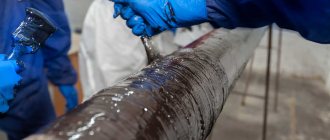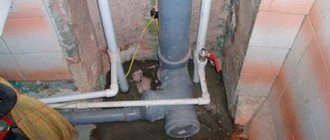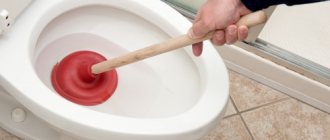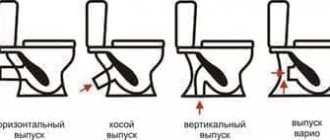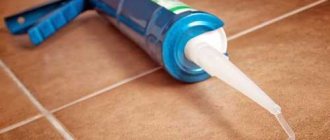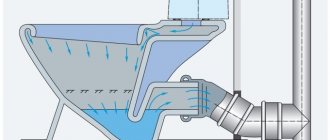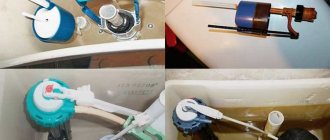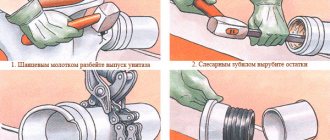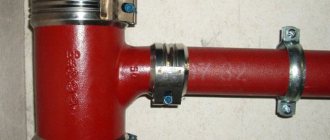- Causes of cracks in the toilet
- What to do to prevent cracks from appearing on the toilet and cistern
- Where do cracks mainly form on the toilet?
- Ways to get rid of cracks
Modern earthenware is made of quite high quality, so it lasts for many years, but the well-known property of ceramics is great fragility. With a certain mechanical impact or impact, plumbing fixtures can be damaged, so we all sometimes face the question of how to repair a crack in a toilet. In this article we will try to understand this issue in detail.
Bonding marble surfaces
Some designs of faucets: a – kitchen faucet, b – kitchen faucet with shower mesh, c – washbasin faucet with controlled outlet.
For gluing marble sanitary ware (toilet shelf, faucet body, sink, cistern), adhesives of very different compositions are used, which require specific application. Let's look at some adhesive compositions.
Universal and familiar to many, universal glue BF-2 is used in almost any plumbing repair. It is suitable for gluing plastic pipes, siphons, thermoplastics, fittings and other similar equipment, as well as for repairing and gluing sanitary ware. And gluing with BF-2 glue is accelerated with subsequent heating of the gluing site.
It is for this purpose that earthenware items, cracked ceramic-coated faucets, toilet tank lids, after gluing, are heated over an electric stove or in an oven heated to 100°C. Faience and ceramics are glued quite reliably with ready-made adhesives: EPD, EPO, MC-1, “Mars”, “Unicum”, “Rapid” and the like.
Which glue to choose?
It is known from practice that to securely fasten ceramic fragments, you can use so-called liquid nails.
If you need to restore the drain tank, then the gluing technology is exactly the same. Sanitaryware and porcelain adhere well to ready-made compounds, which are freely sold in the retail chain.
Among them, we must mention the BF-2 glue, which has proven itself for a long time and has proven itself. The abbreviation BF stands for “butyralphenol”.
The numerical value indicates the percentage of polyvinyl buteral. The higher the number, the higher the elasticity of the adhesive joint. Therefore, BF-6 is not suitable for gluing a toilet bowl.
In order to glue a toilet bowl or cistern, you can use epoxy resin. It glues reliably, but handling it is not very convenient.
It is preferable to use Rapid or Unicum glue. Any of these compounds can also be used to glue the toilet seat together.
In the process of choosing an adhesive composition, each master has to rely on his own experience and advice from those closest to him.
Often you have to prepare such a composition yourself from individual components.
Using liquid nails, you can prepare a high-quality adhesive mixture by adding chalk and a little quicklime. At the same time, you need to know that this composition “sets” very quickly.
It is prepared immediately before gluing. During the gluing process, excess composition must be immediately removed using a rag or soft cloth.
As practice shows, cracks or chips on the toilet often occur. No one living in the apartment is insured against such a nuisance.
If the seat is cracked, it is easier to replace it than to glue it. The glued toilet will, of course, still serve for some time.
At the same time, we must remember that the restored plumbing fixture (including the tank) no longer has its original strength.
And after some time it will have to be replaced with a new one.
Answers from experts
Sidorov Mikhail:
The side of my tank cracked all the way to the bottom. I put it on silicone and coated the wall inside and outside. Two years without problems. But I did it for a while, I thought I’d replace it later. No need.
Veronica Ivanova:
Cold welding
Torpedo boat base:
qualitatively - nothing
Roman Mikhailov:
Use epoxy resin, then rub the seam with zero and cover the top with a thin layer of enamel.
Demitros:
can be glued with liquid nails for plumbing
Izbiratel:
I assume that initially water was dripping or flowing there, and instead of unscrewing and changing the gaskets, you decided to clamp it... I bought another toilet!
Anton Antonenko:
Here
Lilya Kalide:
If “only silicone sealant,” then you lubricate the split with sealant and attach it. then you fill everything with this sealant from the floor and walls to the broken piece, allowing the layers of fill to set so that there is support. as glue the sealant is no good, but as a replacement for the support it might last for a while
Gda:
Someone climbed in with their feet...)))) Change.... or don't change it
Sergey Drozdov:
Previously, we did it ourselves, but now there seem to be adhesive mixtures containing liquid glass (especially for ceramics) on sale. You just need to look for them. All the fragments will stick together perfectly. In some magazine from “Young Technician” from the 80s there was a recipe for such glue. You can google old collections.
GT:
stick a piece of pipe into the tank with sealant and take it out into the toilet, the place where the degrease broke off and glue it to epoxy or silicone.
Vasilevich:
Glue this piece with EDR glue (epoxy resin), I fixed the sink this way, it’s been in use for 10 years now.
Vladimir Nikitin:
A broken toilet shelf under the cistern cannot be repaired. Replacing the toilet.
Adhesive recipes
- To glue a toilet bowl with small cracks, you need to mix one part of borax, 10 parts of casein, 2 parts of water and formaldehyde (aluminum alum is also suitable), which are added to the composition after thoroughly mixing it. The addition of formaldehyde makes the glue waterproof. The final adhesion of the bonded surfaces will occur in a couple of hours. It is not recommended to use the toilet during this time.
- To glue earthenware and porcelain pushes, mix six parts of liquid glass (it can be replaced with liquid nails or silicate glue) with two parts of well-sifted fine sand. The glue adheres reliably, strengthens the base, but requires sanding. The gluing area will be very noticeable even after processing.
- To repair a faience toilet, the composition is prepared immediately before application. You need to mix quicklime, chalk and liquid glass in a ratio of 1:10:2.5.
- Long-lasting universal glue is prepared from turpentine mixed with a double portion of shellac. The ingredients need to be melted, mixed, and slightly cooled. The cracks are glued together with a warm mass. After complete cooling and hardening, the finished glue is cut into pieces that can be stored for a long time in a dark place.
What to do to prevent cracks from appearing on the toilet and cistern
In fact, by adhering to the basic rules, you can easily avoid these unpleasant consequences:
- Always close the lid on the toilet to protect it from foreign objects. In this simple way, you will avoid damage to the earthenware and save your cosmetics or other products from unplanned bathing.
- Never pour hot liquids into the toilet, this will cause temperature changes and your porcelain can be easily damaged. When you need to pour something down the toilet, first let all liquids cool thoroughly.
- Follow all the rules when assembling the toilet, do not apply significant effort. In addition, all bolts must be tightened moderately, not too tightly, but not too loosely, find the golden mean. Also, do not allow any distortions.
These fairly simple rules will allow you to keep your plumbing intact and safe for many years of use.
Best answers
Maygli:
There are atrocious adhesives (China in a small package), dries in 10 seconds. This is only for the crack. He himself will infiltrate where necessary. Only this is needed freshly. No dirt. Try it, maybe it will catch, but the hole is empty. welding for ceramics.
e s:
replace
Roman Serdcev:
Transparent silicone will help you, you just need to dry the edges of the wound))) and degrease... At the same time, tape the cat’s butt so that he can go to his push)))
Michael:
silicone will not help, and it will turn out very rough. There is such a substance as a crystallizer. Used to fill cracks in ceramics and granite. the substance is transparent, similar to varnish. if it's expensive, try waterproof varnish. in both cases, dry and degrease the surface. Good luck!
Gulia:
call a plumber
Alexander Bakushev:
If it's inside the toilet, then it's better not to risk flooding your neighbors! borrow and buy a new one!
Mikhail Shirokov:
If you're not in good condition, you shouldn't cover up the hole, buy a new one, it'll be cheaper, believe me!
Truculentus:
Cold welding. But buying a branded one will keep it.
Heinrich Mont:
I wonder where people “with difficult financial situations” put the brush? For example, I have it near the toilet. Or is your cat trained to wipe the toilet behind itself with a brush? And then the paws slipped?
Ways to get rid of cracks
Of course, all the methods that are used to seal a crack cannot give a one hundred percent guarantee of getting rid of leaks, but they are effective in temporarily solving the problem.
First, let's figure out what you can use to repair cracks. In the modern world there are many materials for these purposes. A small crack or chip can be glued using glue that is designed specifically for ceramic surfaces. In addition, you can use cold welding or epoxy glue.
In the event that a part breaks off that is not involved in ensuring tightness, you can use absolutely any universal glue. First of all, it is necessary to clean the damaged surface from all kinds of contaminants. Leave the earthenware alone for a while and let it dry properly. After this, it is worth degreasing the surfaces with acetone or gasoline. Apply a small layer of glue on the surface and press the broken piece into the desired location. Hold in this position for some time, which is necessary for the glue to dry completely.
During further use, do not forget that your toilet is no longer new, and do not load the adhesive joint to prevent further damage.
If it is necessary to seal a crack in the place where water accumulates, then it is best to use a two-component epoxy resin. To begin, prepare the resin, hardener and mix the components in a container convenient for you according to the manufacturer's instructions. Wipe all surfaces from dust and dirt and wait until they are completely dry. Next, turn off the water. Degrease with gasoline or acetone. Apply the solution prepared in advance on the surfaces that need to be glued.
Fix the chips in the right place; this can be done using tape glued to the outer surface of the toilet bowl. After the resin has completely dried, sand any visible seams. First of all, go over it with zero-grit sandpaper, after which you should apply felt. Do not lose sight of this stage, because in the future, various unpleasant contaminants will collect on these seams without treatment, which will be difficult to remove.
When a crack is noticeable on both sides of the toilet bowl, repairing it will be a little more difficult. Using a drill with a thin drill, which is designed specifically for tiles, you need to drill two small through holes at the ends of the crack. Thanks to this technology, we will not allow the crack to become even larger.
It is necessary to make a depression along the length of the crack using a turbine, but do not allow the toilet to overheat, which can lead to new damage, be very careful. Dilute epoxy resin with hardener in any container according to the manufacturer's instructions. Apply a layer of pre-prepared solution into this recess.
Proceed carefully, remove all excess resin immediately before it has time to harden. Otherwise, you will add additional work to yourself, which consists of sanding surfaces
When all the mortar in the recesses has dried, use sandpaper and then felt to sand all the seams so that they do not collect excess dust and dirt.
If your toilet is cracked at the base, and there is no way to get there from the outside, then do not take any action, otherwise you will only make it worse. In such cases, many enterprising people try to drown the base of the toilet in concrete, but this ultimately does not lead to anything good, because the neighbors below begin to complain about the appearance of fungus in their apartment. Therefore, in this case, you will still have to replace your toilet with a new one.
Now you know what causes cracks in earthenware, as well as all the recommendations that will help you prevent these troubles from occurring. Follow all the above rules, and your toilet can serve you for many years. If trouble does happen, you will find out what materials can be used to seal all the cracks and chips, as well as how this can be done.
You went into the bathroom, and there was a puddle on the floor next to the ceramic toilet, and you were completely unaware of what could be causing it? If the gasket at the entrance to the drain tank is leaking, work for a couple of minutes, it’s another matter when the problem arose due to a crack in the same tank or the bowl of the plumbing fixture itself.
In this case, the work ahead is not so easy, which may even result in a complete replacement of the equipment. If you want to find out how to repair a crack and what you can use to glue a toilet together yourself, read our article further.
Cracked tank: how to seal it
If you are thinking about how and with what to glue the toilet tank, you can use the same tools and technologies as when working with the bowl. However, an important condition is high-quality cleaning of the tank before gluing, especially if the crack is through or has formed on the inside.
Since the tank is constantly in contact with water, limescale forms on its walls, reducing the adhesive properties of the ceramics. You can clean it with regular sandpaper. Work is carried out until the ceramic layer is completely removed and appears. After cleaning, the resulting surface defect is repaired.
Work order
First of all, the split site must be cleared of dust and various small fragments. For this you will need:
- sandpaper;
- soft fabric;
- solvent.
The first step is to clean the place where the piece was broken off. The more complex the crack, the less it is necessary to clean the place, so as not to aggravate the situation. After light sanding, quickly wipe the cleaned area with a soft cloth.
After wiping, lubricate the clean surface with solvent or acetone to degrease the gluing area. After all these procedures, you need a regular or construction hair dryer, which can quickly dry the damaged area.
The split is lubricated with an adhesive waterproof solution or sealant, then the splinter is applied. In some cases, you can use a double layer of glue. It is necessary to apply as much force as possible to create good adhesion to the glue.
But if you overdo it, the chipped part or the chipping site will be destroyed even more, so it is important to calculate your effort
The fragment can be fixed with tape or a tight tourniquet. If everything is done correctly, the chipped part will be firmly glued and can last for quite a long time.
This method is suitable for gluing minor chips on the outer part of the toilet. If the split occurs inside the bowl, then it is better to use epoxy resin instead of the adhesive mixture. But some serious damage cannot be repaired using this method.
For the flush cistern, the procedure is absolutely the same as in the case of the toilet. Usually the material from which the tank is made is a little thinner, so it should stick together faster. To glue large cracks, you can use epoxy resin.
If using resin, you will need to sand the seams and wipe them down with felt to prevent contamination. A toilet tank is much easier to restore than a toilet bowl.
Review of ready-made formulations
Various means are used to eliminate defects in drain tanks. In addition to those described, liquid nails, which are applied according to the specified algorithm, help restore earthenware and porcelain products. Specialized products, such as Unicum, BF-2 or Rapid, can also cope with such defects.
BF-2
BF-2 is a universal adhesive that is used to restore various materials, including sanitary ware. When purchasing this product, you must pay attention to the labeling. A number of varieties of BF-2 are not suitable for gluing toilets.
Unique
One-component epoxy resin based on rubber and other additives. Unicum is characterized by increased resistance to temperature changes, but does not tolerate exposure to open fire.
Rapid
Another type of epoxy resin used to restore plumbing fixtures. Rapid, unlike Unicum, is suitable for eliminating defects on porcelain. This product dries completely within two days.
See also
Basic methods for removing tiles from bathroom walls
First gluing option
Steps for gluing sewer pipes.
In order to seal a crack or glue a chip in a toilet bowl or cistern, you need to prepare the following:
- waterproof glue, cold welding, epoxy or silicone sealant;
- fine sandpaper;
- acetone or solvent;
- narrow spatula for convenient application of adhesive material;
- rags;
- construction hair dryer (you can also use a home hair dryer).
First of all, the chip and damaged surface is thoroughly cleaned with sandpaper, a hairdryer or rags, and freed from small particles. Then both surfaces are degreased with a solvent or acetone and then heated well with a hairdryer to evaporate as much moisture as possible from the area of the future seam.
Stages of installing a toilet.
So, on a cleaned, degreased and well-dried surface, you need to very carefully apply a thin layer of glue and wait for the required time according to the attached instructions. Only after this the pieces need to be pressed together as tightly as possible for several minutes.
If you carry out this stage correctly, you can forget about the chip for several years. But you should know that both the damaged cistern and toilet, even if the chip site is not very noticeable or not visible at all, will require additional treatment of the seam. First of all - to strengthen it, and secondly - for aesthetic purposes.
So, the external seam obtained as a result of gluing a toilet bowl or cistern must be treated with joint putty used for ceramic tiles, or with a special epoxy with a filler that is best matched to the color of the plumbing fixture being repaired. The inside of the toilet bowl or cistern at the junction of the seams is reinforced with an additional layer of glue and a strip of soft stainless metal or thin plastic. The reinforcement area is first cleaned with sandpaper, degreased and dried with a hairdryer.
You can glue a crack in a tank or toilet using a similar method. The internal and external surfaces of the crack area are cleaned, degreased and thoroughly dried. The treated area is then carefully coated with epoxy. And from the inside, the cistern or toilet at the site of the split is strengthened by gluing a strip of plastic or soft stainless metal. On the outside, after the epoxy glue has dried, the crack area should be additionally coated with waterproof glue.
How to glue a cracked toilet
You can seal the toilet using the same method as any porcelain or ceramic products. For this purpose, specialized adhesives or universal reliable glue are used. Epoxy resin and other moisture-resistant binders are also suitable.
The disadvantage is the relatively smooth texture of the chip, which does not have a high enough level of adhesion for gluing to be carried out quickly. So don't be discouraged if something goes wrong the first time. You may have to repeat the procedure, completing all the individual steps better.
What you will need
In order to seal a crack on a toilet, you will need a fairly simple set of accessories:
- Fine polishing sandpaper;
- Wipes for removing excess adhesive;
- Acetone or gasoline to degrease the surface;
- The adhesive composition itself, which can be selected in accordance with the recommendations given below;
- Adhesive tape for fixation.
Before carrying out work, you need to turn off the water, remove excess water from the toilet, and dry the work area. This is a general recommendation for all types of gluing jobs.
Surface preparation
Before gluing, you will need to carefully treat the surface to improve the quality of adhesion of the materials.
One-sided damage - clean the gluing area from any dirt that may have accumulated inside. You can use a stiff brush for cleaning. After cleaning, it is necessary to degrease the ceramics using acetone or alcohol;
The gluing areas on the fragment and on the toilet are cleaned of dirt and loose parts. Next, the surface is degreased with acetone and glued;
Double-sided cracks - in this case, preparation is more difficult. To do this, you need to drill a hole at the end of the crack, this will prevent further splitting. Use thin ceramic glass for drilling.
Next, you need to embroider the ditch with a grinder to half the thickness of the ceramic. Then you need to degrease the surface. In this case, gluing is done using a two-component epoxy resin.
Preparation is an important step. The strength of the connection subsequently depends on the quality of the work performed.
Seam gluing
When gluing a crack, it is important to choose the right composition:
- Universal waterproof adhesive for ceramics and glass - suitable for gluing a broken part from a rim or other place where there is no contact with water. Waterproof glue bonds sanitary ceramics well;
- Epoxy Resin – A two-part epoxy that can handle through-hole joints, sealing them for a long time. Can be used in areas in contact with water;
- Silicone sealant or liquid welding is used to seal the resulting scratches and prevent their further growth.
The listed materials do an excellent job and can extend the life of the tank or toilet for a long period. However, in practice, with end-to-end splits, all measures are temporary.
How to glue ceramic toilets and installations made of other materials
What are toilets made of? This question arises when the device needs repair, because in a modern well-appointed home it is impossible to do without this installation. If you believe the statistics, then, taking into account certain conditions, the device is used every 6-7 minutes.
Taking these circumstances into account, toilets are made from:
- Porcelain;
- Ceramics;
- Faience
- Become.
Toilet bowls require not only mechanical strength, but also the ability to withstand chemical influences. Speaking about devices that use ceramics, we can say that they are not only the most popular, but also the best among other products.
At the moment, people have extensive experience in installing and repairing toilets, but as practice shows, if the installation is carried out correctly, then there is no further operation. This is what leads to both partial and complete destruction of products.
What could have happened
Before we find out how to seal a ceramic toilet, let's understand where our crack came from so as not to waste time.
Falling objects In a cramped bathroom in a city apartment, everyone wants to make the most of its space. Therefore, a cabinet with various household chemicals, and often with tools, is often installed above the toilet bowl.
If you are careless, they can fall into the toilet, causing it to immediately crack.
Sudden changes in temperature Ceramics do not like sudden changes in temperature. In this case, an uneven expansion of the material is created, due to which internal stresses in it increase
The result of such actions is a crack. This can happen due to a faulty mixer when hot water begins to flow into the pipes with cold water. The plastic parts will begin to deform. After this, cold water will flow again, which can cause cracks, and you will have to think about how to seal the toilet tank.
Incorrect assembly Do not apply large amounts of force during the process. Make sure the bolts are evenly tightened. Otherwise, these two conditions will become harbingers of cracks. In this case, the tank and toilet may burst after a period of time, even a very long one.
- Close the toilet lid
. A seemingly simple operation will help protect the bowl from foreign objects getting into it, which can cause chips and cracks. In addition, your valuables will also not fall into the water. - Do not pour hot liquid into the toilet; be sure to let it cool
. Agree, purchasing a new toilet and installing it will cost much more than an old pot or pan. This also applies in winter. You should not direct water at a temperature of 80-90˚ into the toilet bowl.
- During assembly, make sure there are no distortions and do not use excessive force
; remember that the product is made of clay, not metal or wood. If the toilet tank is cracked, you will find out how to seal it in the article below.
So, we have found out what can mainly lead to cracks in a ceramic toilet or cistern. Now let's move on to their repair.
How to glue a toilet and cistern together yourself
We use universal glue
This method will help to repair the product when a fragment breaks off, which is not related to ensuring tightness. For example, part of the base and an eyelet for attaching a shelf.
Buy any universal glue from a trustworthy manufacturer, its price cannot be low. “Supermoment” from Henkel is quite suitable.
The instructions are as follows:
- Clean the surface of the defect from crumbs and dust.
- Let the product dry completely.
- Degrease surfaces with gasoline or acetone.
- Apply glue and press the broken piece. Fix in any way for the time specified in the instructions for the composition.
The crack is only on the outside
In this case, consider the moment when an object fell into the toilet bowl and damaged it. It is better to replace universal glue with two-component epoxy resin.
So, how to glue a toilet:
- Prepare the components - resin and hardener, as well as a container for mixing them.
- Dry the surfaces to be glued thoroughly.
- Turn off the water supply to the tank, install a fan, and wipe off any drops. Make sure the gluing area is completely dry.
- Degrease surfaces.
- Mix the resin and hardener together according to the manufacturer's recommendations.
- Apply glue to the surfaces to be glued.
- Be sure to secure the gluing area in any way. For example, you can use regular tape and stick it on the outside of the bowl.
- When the resin has dried, carefully sand down the glue lines where they are visible. First use M20 or M40 sandpaper, then felt. Otherwise, pollution will accumulate here.
The crack is visible on both sides of the bowl
Now we’ll find out how to seal a crack in the toilet, which affects its tightness. In this case, it is also necessary to prevent the defect from growing.
Prepare:
- epoxy resin with hardener;
- drill with a thin drill bit for tiles;
- grinder with a disc for stone;
- sandpaper and felt for sanding the gluing area.
All that remains is to find out how to seal a toilet with your own hands:
Drill 2 thin through holes at the ends of the crack. This will stop it from lengthening. Using a grinder, select a recess along the entire crack approximately 50% of the thickness of the earthenware. At the same time, do not forget that overheating the material will only aggravate the situation; it may begin to crack in other places
It doesn't matter where you do it - outside or inside the bowl, the crack will still be noticeable. Fill the prepared recess and holes with a mixture of resin and hardener, remove the excess immediately to save less sanding later
Sand the hardened resin.
Selecting glue wisely
When starting to carry out repair work related to gluing the product, you need to select an adhesive composition. Experienced craftsmen prefer to use silicate glue.
This composition has the following characteristics:
- fire resistance;
- resistance to sudden temperature changes;
- waterproof;
- long operating time.
Using this glue, you can prepare adhesive compositions yourself. They are the best option when performing repair work, since plumbing fixtures have sodium silicate in their structure. As another option, you can buy ready-made adhesive mixtures. They need to be selected taking into account the main characteristics, which will allow you to get the result.
BF-2
The adhesive composition is a viscous liquid that has a reddish tint. It is based on an alcohol solution of polyvinyl acetate with the addition of a resin complex. It is waterproof and prevents mold from appearing on the surface of the device. It should be remembered that the composition, as indicated by the instructions, is flammable. Therefore, it is better to use in a ventilated area.
Unique
The adhesive consists of rubber supplemented with reinforcing additives. If you use this composition, the seam can withstand temperatures from −40 to 70 degrees. Before gluing, you need to clean the surface of the plumbing fixture. After these steps, you can apply a thin layer of glue. After ten minutes, you can apply a second layer. After another 10 minutes, it is necessary to press the planes to be glued. You can use the product only after 24 hours. Safety precautions must be observed. The mixture can only be kept away from heat appliances.
Rapid
The adhesive composition is based on nitrocellulose. The glue also contains resins and organic-based diluents. Before using the composition, the surface must first be degreased and dried. The applied layer must dry within twenty minutes. Then you need to apply a second layer. The planes must be firmly pressed together and secured. The composition will dry completely after two days.
It will be interesting: We create a water leakage control system using improvised means
